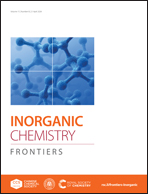Selective syntheses of homoleptic Ir(iii) complexes bearing di-CF3-functionalized benzoimidazol-2-ylidenes for generation of blue phosphorescence†
Abstract
Homoleptic Ir(III) based carbene complexes are known to be the most promising emitters of future blue OLED devices. To provide the proof-of-concept, we designed a series of functional di-CF3-functionalized benzo[d]imidazol-3-ium pro-chelates, which could afford single product emitters after proper modification. For benzoimidazol-2-ylidene with an N-methyl substituent, selective formation of the product can be achieved by introduction of t-butylphenyl for the phenyl group, as shown by shifting the product from mixed m-Ir(dfp)3 and f-Ir(dfp)3 to the single isomer f-Ir(dfpb)3. Alternatively, for di-N-aryl substituted carbene chelates, the steric encumbrance imposed between the ortho-CF3 group and the adjacent N-aryl substituent redirects the cyclometalation to the other N-aryl substituent, leading to the formation of one single product, e.g., f-Ir(tBpp)3 and f-Ir(ptBp)3. Moreover, the doped OLED based on f-Ir(tBpp)3 delivered true-blue emission centered at 457 nm and a maximum EQE of 15.6%. Furthermore, upon addition of terminal emitters ν-DABNA and t-DABNA, the respective hyper-OLEDs exhibited narrowband blue emission with a maximum EQE of 18.9% at 474 nm and 18.1% at 462 nm, respectively. These highlighted the potential of these Ir(III) emitters in the fabrication of blue OLEDs.



 Please wait while we load your content...
Please wait while we load your content...